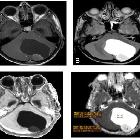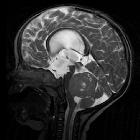Tumoren der hinteren Schädelgrube
 ähnliche Suchen
ähnliche SuchenTumoren der hinteren Schädelgrube
Posterior fossa tumors
posterior fossa mass
posterior fossa tumour
posterior fossa tumours
paediatric posterior fossa tumours
Posterior fossa tumor
Posterior fossa tumours in children
Pediatric posterior fossa tumors
Posterior fossa tumors in children
paediatric posterior fossa tumours (mnemonic)
Posterior fossa tumors
posterior fossa mass
posterior fossa tumour
posterior fossa tumours
paediatric posterior fossa tumours
Posterior fossa tumor
Posterior fossa tumours in children
Pediatric posterior fossa tumors
Posterior fossa tumors in children
paediatric posterior fossa tumours (mnemonic)
 siehe auch
siehe auchPilozytisches Astrozytom
Ependymom
Teratom
brainstem glioma
Astrozytom
Hämangioblastom
Medulloblastom
Morbus Hippel-Lindau
Apoplex
posterior fossa astrocytoma
Tumoren der Schädelbasis
AV Malformation hintere Schädelgrube
cerebellar metastases
Hirnnervenlähmungen
intrakranielle Lipome der hinteren Schädelgrube
atypischer teratoider rhabdoider Tumor
Medulloblastom bei Erwachsenen
Meningeom der hinteren Schädelgrube
BEAM (Merkhilfe Tumoren der hinteren Schädelgrube bei Kindern)
primary brain tumour
Ependymom
Teratom
brainstem glioma
Astrozytom
Hämangioblastom
Medulloblastom
Morbus Hippel-Lindau
Apoplex
posterior fossa astrocytoma
Tumoren der Schädelbasis
AV Malformation hintere Schädelgrube
cerebellar metastases
Hirnnervenlähmungen
intrakranielle Lipome der hinteren Schädelgrube
atypischer teratoider rhabdoider Tumor
Medulloblastom bei Erwachsenen
Meningeom der hinteren Schädelgrube
BEAM (Merkhilfe Tumoren der hinteren Schädelgrube bei Kindern)
primary brain tumour
Posterior fossa tumor has a very different differential in an adult as opposed to a child.
Adult
- cerebellar metastases (most common)
- especially lung cancer and breast cancer
- also melanoma, thyroid malignancies, and renal cell cancer
- gastrointestinal stromal tumor (very rare)
- hemangioblastoma: most common posterior fossa primary brain tumor in adults
- astrocytomas, medulloblastomas, and ependymomas are encountered in the posterior fossa of younger adults but are rare in older adults, accounting for <1% all tumors
- posterior fossa meningioma
- lymphoma
- lipoma
- Lhermitte-Duclos disease
- medulloblastoma in adults
An important space-occupying lesion (the most common in fact) to remember is that of a stroke, which when subacute can mimic a tumor.
Child
- posterior fossa astrocytoma
- pilocytic astrocytoma: second most common (25-35%)
- brainstem glioma
- medulloblastoma: most common (30-40%)
- ependymoma
- atypical teratoid/rhabdoid tumor (AT/RT)
- hemangioblastoma (uncommon except in patients with vHL)
- teratoma (in infants)
A quick and handy mnemonic for posterior fossa tumors in children is BEAM.
Although it is true that posterior fossa tumors are much more common in children than in adults the distribution does vary with age :
- 0 to 3 years of age: supratentorial > infratentorial
- 4 to 10 years of age: infratentorial > supratentorial
- 10 to early adulthood: infratentorial = supratentorial
- adults: supratentorial > infratentorial
Overall 50-55% of all brain tumors in children are found in the posterior fossa .
Siehe auch:
- Pilozytisches Astrozytom
- Ependymom
- Teratom
- brainstem glioma
- Astrozytom
- Hämangioblastom
- Medulloblastom
- Morbus Hippel-Lindau
- Apoplex
- posterior fossa astrocytoma
- Tumoren der Schädelbasis
- AV Malformation hintere Schädelgrube
- cerebellar metastases
- Hirnnervenlähmungen
- intrakranielle Lipome der hinteren Schädelgrube
- atypischer teratoider rhabdoider Tumor
- Medulloblastom bei Erwachsenen
- Meningeom der hinteren Schädelgrube
- BEAM (Merkhilfe Tumoren der hinteren Schädelgrube bei Kindern)
- primary brain tumour
und weiter:
 Assoziationen und Differentialdiagnosen zu Tumoren der hinteren Schädelgrube:
Assoziationen und Differentialdiagnosen zu Tumoren der hinteren Schädelgrube:


































